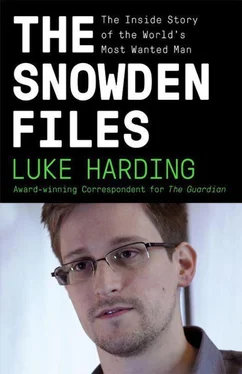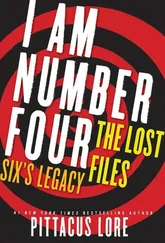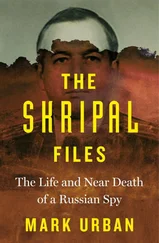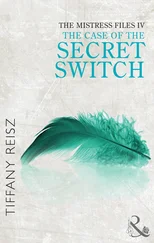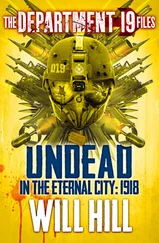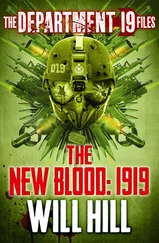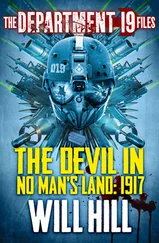Millar headed off back to work a mere 20 minutes later, to discover that diggers had mysteriously arrived at 536 Broadway. They were tearing up the pavement immediately in front of the Guardian ’s office, a strange activity for a Wednesday evening. With smooth efficiency, they replaced it. More diggers arrived outside Gibson’s home in Brooklyn. Construction crews also began very loud work outside the Guardian ’s Washington bureau. Soon, every member of the Snowden team was able to recount similar unusual moments – ‘taxi drivers’ who didn’t know the way and forgot to ask for money, ‘window cleaners’ who lingered and re-lingered next to the editor’s office.
In the coming days the Guardian ’s laptops repeatedly stopped working. Gibson was especially unlucky. Her mere presence had a disastrous effect on technology. Often her encrypted chats with Greenwald and others would collapse, raising fears of possible hacking. She stuck a Post-it note on one compromised machine. It read: ‘Middlemanned! Do not use.’ Having glimpsed Snowden’s documents, it was clear the NSA could ‘middleman’ practically anything, in other words insert itself in the middle of a conversation between two parties and siphon off private data. All the players involved in the Snowden story went from being encryption novices to encryption mavens. ‘Very quickly, we had to get better at spycraft,’ Gibson says.
That evening, the bleary-eyed journalists began pulling into shape the next exclusive on PRISM. At midnight Rusbridger and Borger walked in; on the plane over, Rusbridger had been mugging up on US law and the Espionage Act. The following morning on the subway to Spring Street station, the nearest to the New York office, the pair had overshot their stop. They ran up the stairs, and dived into a train heading in the opposite direction. ‘That will shake them off,’ Rusbridger joked. The mood was jubilant as Rusbridger read through the draft of the next story, about PRISM.
That story, too, was remarkable. The NSA was claiming it had secret direct access to the systems of Google, Facebook, Apple and other US internet giants. Under the program, previously undisclosed, analysts were able to collect email content, search histories, live chats and file transfers. The Guardian had a 41-slide PowerPoint presentation, classified as top secret and not to be shown to foreign allies. It was apparently used to train analysts. The document claimed ‘collection directly from the servers’ of major US service providers. Silicon Valley would vehemently deny this.
As the team reassembled the next morning there were still difficult editorial decisions to make. How many of the slides, if any, should the Guardian publish? Several gave details of previously undisclosed intelligence operations abroad. There was no public interest in betraying them. It was also important – legally, and in the interests of fairness – to approach the US tech companies for reaction. Dominic Rushe, the Guardian ’s US business reporter, was assigned the task. And then there was the White House. PRISM was an even bigger secret than Verizon. How much warning should the White House get ahead of publication?
Gibson picked up the phone for another difficult conversation. On the other end of the line was Bob Litt and the director of national intelligence’s press spokesman Shawn Turner; other security agencies were patched in. Gibson explained this was another opportunity for the White House to raise specific national security concerns. She was asked, in tones of friendly banter: ‘Could you send us a copy of your story and we’ll take a look at it for you?’ It was maybe worth a shot. Gibson replied: ‘We’re not going to do that.’
There were issues with many of the slides. The problem was that the White House’s and the Guardian ’s slide-decks didn’t quite match up; the colours were different. At one point Gibson said: ‘I’m really sorry. It’s just inherently comedic when you say the words purple box.’ From the Guardian side laughter, from the White House bemusement. It was another moment of cross-cultural confusion.
The NSA, not surprisingly, was against publication of any of the slides; the agency’s bad week was morphing into full-blown disaster. Gibson, however, was insistent the Guardian should disclose the dates when Microsoft, Yahoo and other tech giants had apparently signed up to the aggressive PRISM program; it was a key slide. ‘We need to publish this. That’s my bottom line,’ she said, stressing: ‘We’ve taken out anything operational.’
The Obama team had apparently still not entirely grasped that they had lost control irrevocably of a large cache of top-secret NSA material. As Gibson put it, reflecting on the non-existent leverage available to the US authorities: ‘I could not understand what the “or else” in this was.’ The Guardian decided it would publish only three out of the 41 slides, a conservative approach. The White House had been told the story would go live at 6pm. A few minutes earlier, the Washington Post , which had been sitting on some similar material, published its own version of the PRISM story. The immediate suspicion was that someone inside the administration had tipped off the Post . The Post article, however, lacked one crucial element: howling denials from Facebook and others that they were complicit in NSA surveillance.
In mid-afternoon, Gibson, Rusbridger and the others gathered in the large meeting room at the end of the office. The area had been jokingly dubbed the ‘Cronut’. The reference was to GCHQ’s doughnut-shaped headquarters in England, and to the latest SoHo craze for ‘cronuts’, a cross between a croissant and a doughnut. Several young interns had been liquidising cronuts at a nearby desk; they were writing a feature. Cronut was, perhaps, not the funniest pun in the world. But in these febrile times it stuck.
The mood was lightening – two massive stories, Snowden still in play, an engagement process of sorts with the White House. After a succession of long days merging into muggy nights, the working environment resembled an unkempt student dormitory. Cardboard rectangles of grubby pizza boxes littered the tables; there were take-away cups and other detritus. Someone knocked over a cappuccino. This was Rusbridger’s cue. He reached down for the nearest newspaper, began theatrically mopping up the coffee, and declared: ‘We are literally wiping the floor with the New York Times .’
The Snowden revelations were becoming a deluge. On Friday morning the Guardian published an 18-page presidential policy directive, dated October 2012 – the document Snowden had revealed to Poitras. It showed that Obama had ordered officials to draw up a list of potential overseas targets for offensive US cyber-attacks. Like other top-secret programs, the policy had its own acronym – OCEO – or Offensive Cyber Effects Operations. The directive promised ‘unique and unconventional capabilities to advance US national objectives around the world with little or no warning to the adversary or target.’ The potential effects, it boasted, ranged ‘from subtle to severely damaging’.
The story was a double embarrassment for the White House. First, the US had complained persistently about invasive and damaging cyber-attacks from Beijing, directed against American military infrastructure, the Pentagon and other targets. These complaints now looked distinctly hypocritical; the US was doing exactly the same. Second, and more piquantly, Obama was due later that day to meet his Chinese counterpart Xi Jinping at a summit in California. Beijing had already hit back at US criticism. Senior officials claimed to have ‘mountains’ of evidence of US cyber-attacks, every bit as serious as the ones allegedly carried out by rampant Chinese hackers.
Читать дальше
